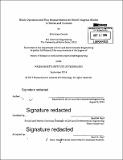| dc.contributor.advisor | Heidi M. Nepf. | en_US |
| dc.contributor.author | Connor, Erin Grace | en_US |
| dc.contributor.other | Massachusetts Institute of Technology. Department of Civil and Environmental Engineering. | en_US |
| dc.date.accessioned | 2015-02-25T17:11:00Z | |
| dc.date.available | 2015-02-25T17:11:00Z | |
| dc.date.copyright | 2014 | en_US |
| dc.date.issued | 2014 | en_US |
| dc.identifier.uri | http://hdl.handle.net/1721.1/95573 | |
| dc.description | Thesis: S.M., Massachusetts Institute of Technology, Department of Civil and Environmental Engineering, 2014. | en_US |
| dc.description | Cataloged from PDF version of thesis. | en_US |
| dc.description | Includes bibliographical references (pages 113-117). | en_US |
| dc.description.abstract | Complex interactions between flow conditions, blade posture, and mass transport processes, represent a challenge to fully understanding the influence of hydrodynamic conditions on the flux of nutrients to the blade surface of submerged aquatic vegetation. To isolate the physical mechanisms from biological processes, model seagrass blades constructed from low-density polyethylene (LDPE) film were used as a laboratory proxy. In accordance with previous studies of LDPE, the balance of the drag force due to fluid motion and the restoring force due to blade stiffness determined the blade posture in unidirectional flow and the relative motion in oscillatory flow. The blade rigidity was adjusted by changing either the blade length or the blade thickness. Horizontal force measurements showed that the reconfiguration of blades in flow resulted in a less than quadratic power-law relation between force and velocity. Specifically, F - U³/⁴. Two techniques and two tracer chemicals (dibromochloromethane and 1,2-dichlorobenzene) for estimating uptake by LDPE, as an analogue to nutrient uptake by seagrass, are described and compared. Mass uptake by blades during flux experiments demonstrated mixed control by both the LDPE-side and water-side mass transfer velocities. In experiments using 1,2-dichlorobenzene, measured uptake was fit to a numerical diffusion model to estimate the water-side transfer velocity. The water-side transfer velocity had a non-linear dependence on velocity in that the rate of increase of the mass transfer velocity decreased with greater blade bending in flow. | en_US |
| dc.description.statementofresponsibility | by Erin Grace Connor. | en_US |
| dc.format.extent | 117 pages | en_US |
| dc.language.iso | eng | en_US |
| dc.publisher | Massachusetts Institute of Technology | en_US |
| dc.rights | M.I.T. theses are protected by copyright. They may be viewed from this source for any purpose, but reproduction or distribution in any format is prohibited without written permission. See provided URL for inquiries about permission. | en_US |
| dc.rights.uri | http://dspace.mit.edu/handle/1721.1/7582 | en_US |
| dc.subject | Civil and Environmental Engineering. | en_US |
| dc.title | Blade dynamics and flux measurements for model seagrass blades in waves and currents | en_US |
| dc.type | Thesis | en_US |
| dc.description.degree | S.M. | en_US |
| dc.contributor.department | Massachusetts Institute of Technology. Department of Civil and Environmental Engineering | |
| dc.identifier.oclc | 903591818 | en_US |
